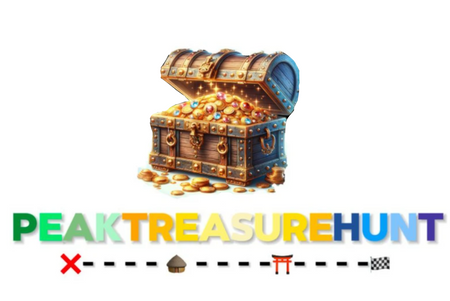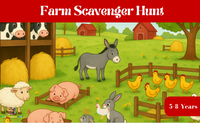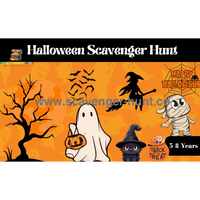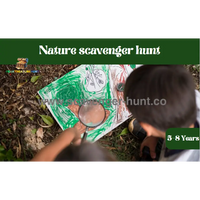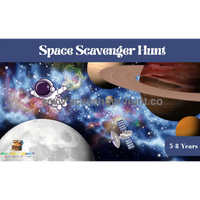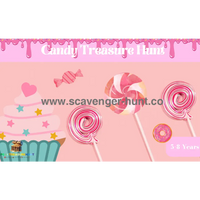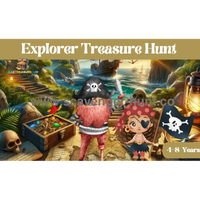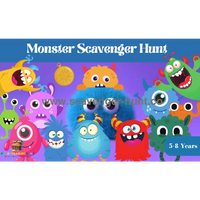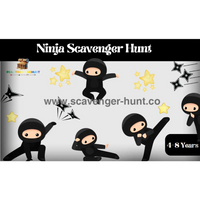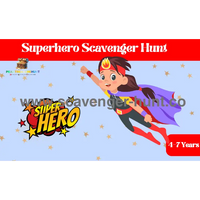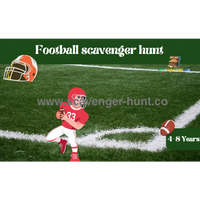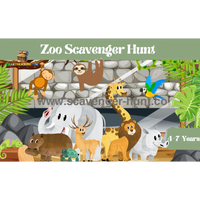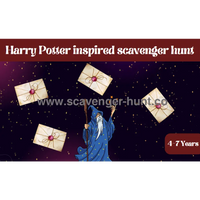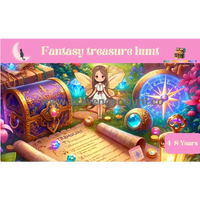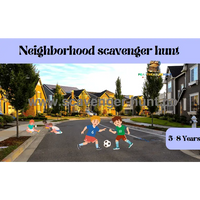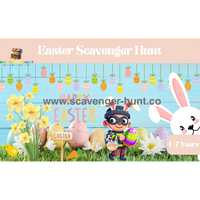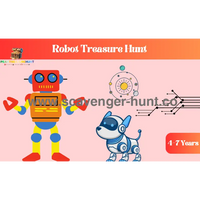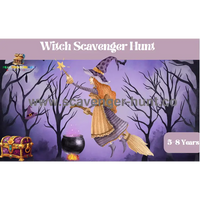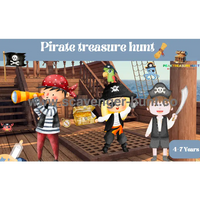🍄 The Ultimate Treasure Hunt Guide for Garden Treasure Hunts
Welcome to the magical world of garden treasure hunts! As a mother of four wonderful kids, I've organized countless outdoor adventures that have brought sparkles to my children's eyes. Whether you have a tiny garden or a huge garden, transforming your outdoor space into a treasure-seeking paradise is easier than you might think. This guide will help parents create unforgettable treasure hunt experiences that combine fun, learning, and plenty of fresh air for kids aged 4-12.
Planning Your Garden Treasure Hunt
Creating the perfect garden treasure hunt starts with good planning. Here's what you'll need:
- Age-appropriate clues (Picture riddles for younger kids, written riddles for older ones)
- Weather-resistant materials (laminated cards work great!)
- Small prizes or "treasure" (think surprise egg toys or nature-themed rewards)
- Safety consideration for different age groups
Pro-Tip: In my experience, a 30-45 minute hunt works best for maintaining excitement without overwhelming young participants.
Planning a garden treasure hunt can be one of the most exciting and memorable experiences for kids! Whether it’s for a birthday party, a sunny weekend, or just a fun afternoon, a treasure hunt can turn your garden into an adventurous playground. Let’s dive into how to plan an amazing garden treasure hunt that your children will talk about for years to come!
Step 1: Choosing the Right Theme 🎉
First things first: decide on a theme for your treasure hunt. The theme can set the mood and excitement level for the kids. Here are a few fun ideas:
-
Pirate Adventure: Imagine your kids dressed as pirates, searching for buried treasure! Use a pirate map and have “X marks the spot” for the final treasure.
-
Nature Explorer: Incorporate elements of nature by having kids find specific leaves, flowers, or rocks as clues. This theme can also help them learn about the plants in your garden!
-
Fairytale Quest: Turn your garden into a magical land where kids are knights or fairies on a quest to find the enchanted treasure.
Selecting a theme will make the treasure hunt more immersive and entertaining! 🏴☠️🌼
Step 2: Creating Clues and Riddles 🔍
Once you have your theme, it's time to craft clues that will lead the children from one location to the next. Here are a few tips for creating engaging clues:
-
Keep it Age-Appropriate: For younger children (ages 4-6), simple picture clues or rhymes work well. For older kids (ages 7-12), you can use riddles or puzzles that require some thinking.
-
Example Clue for Young Kids: “I am green and grow tall, with branches for you to climb. Look for me in the corner, and you’ll find your next sign!”
-
Example Riddle for Older Kids: “I’m not a plant, but I do help things grow. I hold your garden treasures, and you should know where I go. What am I?” (Answer: A pot!)
-
Use Your Garden: Think about the unique features of your garden and use them in your clues. For instance, if you have a birdbath, a clue could say, “Where birds take a drink, look underneath the sink!”
-
Map It Out: You could create a simple map of your garden to help guide the kids to various locations. Mark each clue’s spot on the map, and encourage them to use it as a guide.
Step 3: Hiding the Treasure 🏴☠️
Now that you have your clues ready, it’s time to hide the treasure! The treasure can be anything from small toys, candy, or even a fun certificate that says they’re an official treasure hunter! Here are some ideas on how to hide the treasure:
-
In a Decorative Box: Use a treasure chest or a decorated box to make it feel special. You can find inexpensive treasure chests at craft stores or even use a shoebox decorated with paint and stickers.
-
Underneath a Rock or Plant: For a more adventurous feel, consider hiding the treasure under a large rock or beneath a bush. Just be sure it’s in a safe spot that kids can easily reach.
Make sure that wherever you hide it, it’s well camouflaged yet easy enough for the kids to find after they complete the clues! 🌟
Step 4: Setting Up the Treasure Hunt 🎈
On the day of the treasure hunt, gather the kids and explain the rules. Here are some pointers to ensure everything runs smoothly:
-
Divide into Teams: If you have a larger group, split the kids into teams. This encourages teamwork and can make it more competitive and fun!
-
Give Each Team a Starting Clue: Hand out the first clue to each team to kick off the hunt. You can even create a little backstory for the treasure hunt to spark their imagination! For example, “Once upon a time, a pirate hid his treasure in this very garden, and we need your help to find it!”
Step 5: Celebrate! 🎊
After the treasure is found, it’s time to celebrate! Gather the kids to show them the treasure they found. Consider having some treats ready, like cupcakes or juice boxes, to keep the energy up after all that excitement. You can also have fun awards, like “Best Treasure Hunter” or “Best Teamwork,” to hand out at the end.
In conclusion, planning a garden treasure hunt doesn’t have to be complicated. With a little creativity, a few clues, and some hidden treasures, you can create an unforgettable adventure for your children. So, get your treasure maps ready, and let the hunt begin! 🗺️✨
Creating Exciting Clues and Routes
The heart of any successful treasure hunt lies in its clues. Consider these tested approaches:
- Nature-based hints ("Look under the tallest sunflower")
- Picture clues for non-readers
- Mathematical puzzles for older kids
- Rhyming verses
Remember: Gardens often have unique features like garden gnomes - use them in your clues!
One of the most thrilling parts of planning a treasure hunt is crafting the clues and routes that will guide your young adventurers on their quest! The right clues can spark curiosity, challenge their minds, and keep them engaged throughout the hunt. In this chapter, we’ll explore how to create exciting clues and fun routes that will make your treasure hunt unforgettable! 🎉
Step 1: Understanding Your Audience 👶👦👧
Before you start crafting your clues, it’s essential to consider the age and abilities of the children participating in the treasure hunt. Younger kids may enjoy simple riddles or picture clues, while older children might relish the challenge of more complex puzzles or codes. Here’s a breakdown to help you tailor your clues:
-
Ages 4-6: Use colorful images or symbols as clues. For example, a picture of a tree could lead them to “where the leaves are green.”
-
Ages 7-9: Incorporate rhymes or simple riddles that require some thought. An example could be, “I have keys but open no locks. I have space but no room. I have a mouth but never speak. What am I?” (Answer: A piano!)
-
Ages 10-12: Challenge them with more difficult puzzles, codes, or even a scavenger hunt list. Use ciphers or riddles that require teamwork to solve.
By understanding your audience, you can ensure the clues are engaging and appropriately challenging! 🧠✨
Step 2: Crafting Creative Clues 📝🎨
Now that you know who your treasure hunters are, it’s time to get creative with your clues! Here are some ideas to inspire you:
-
Riddles and Rhymes:
- Riddles are a fun way to get kids thinking. Try something like, “I can fly without wings. I can cry without eyes. Whenever I go, darkness flies. What am I?” (Answer: A cloud.)
- Rhyming clues can make the hunt more playful. For example: “In the place where flowers bloom, look under the one that fills the room.” 🌼
-
Picture Clues:
- Draw or print pictures that represent the next location. A photo of a swing set could lead to a clue hidden at the playground.
-
Word Scrambles or Ciphers:
- Create a simple code or scramble words that they need to decode. For example, “WLAK ITOTHE RED TRE” (Answer: Walk to the red tree) is a fun way to make kids think!
-
Physical Challenges:
- Incorporate a task that must be completed to earn the next clue. For instance, “Do five jumping jacks before you can find the next clue hidden by the garden gnome!” 🤸🦙
-
Map Directions:
- If your garden is large enough, consider giving them a hand-drawn map with marked spots to find clues. You can indicate “hot” and “cold” areas based on how close they are to the next clue! 🔥❄️
Step 3: Designing the Routes 🏃💨
With your clues ready, it’s time to design the routes that the children will take during the treasure hunt. Here are some tips for creating a fun and engaging route:
-
Start and End Points:
- Choose a clear starting point (like the patio or a picnic table) and a final destination for the treasure. This helps keep things organized.
-
Logical Progression:
- Arrange the clues in a logical order that guides the kids from one location to the next. Ensure each clue leads smoothly to the following one.
-
Mix It Up:
- Incorporate a variety of locations around your garden to keep the excitement alive. Some clues can be hidden in obvious places (like under a flower pot), while others can be more challenging (like tucked inside a birdhouse).
-
Add Obstacles or Stations:
- To keep the kids engaged, consider adding stations where they must perform an activity, like a mini-game, to earn their next clue. For example, they might have to toss a beanbag into a bucket before moving on! 🎯
-
Safety First:
- Make sure the route is safe for all participants. Keep an eye out for any potential hazards, like slippery areas or sharp objects. Kids will have more fun if they can explore without worrying about safety.
Step 4: Testing the Clues and Routes 🔄✅
Before the big day arrives, it’s wise to test out your clues and routes to ensure everything flows smoothly. Here’s how to do it:
-
Walk Through the Hunt: Go through the treasure hunt yourself, following each clue and route. This will help you spot any areas that might be confusing or too difficult for the kids.
-
Ask for Feedback: If possible, enlist the help of an adult friend or sibling to give feedback on the clues. They can provide insights on what works and what may need adjustments. 👥
-
Make Adjustments: Don’t hesitate to tweak clues or routes based on your trial run. The goal is to make the treasure hunt enjoyable and fun!

Adding Educational Elements
Transform your garden treasure hunt into a learning experience:
- Include plant identification tasks
- Add simple counting exercises
- Incorporate seasonal changes
- Include local wildlife spotting
Statistics show that outdoor learning activities improve children's retention by up to 73%!
Treasure hunts are not only about fun and adventure; they can also be a fantastic way to sneak in some educational elements! By incorporating learning into the treasure hunt, you can create an experience that is both entertaining and enriching. In this chapter, we’ll explore various ways to weave educational aspects into your treasure hunt, making it an unforgettable experience for kids while enhancing their knowledge and skills! 🌟
Step 1: Choose Your Educational Focus 🎯
Before diving into the details, think about the educational goals you want to achieve. Here are some themes you could consider:
-
Math Skills: Incorporate counting, measuring, or simple math problems into your clues. For example, kids might need to solve a math equation to get their next clue or measure something in the garden.
-
Reading and Language Arts: Use riddles, poems, or stories as clues. This encourages kids to practice reading comprehension and vocabulary.
-
Science Exploration: Use your garden's plants and insects as teaching tools. You can incorporate facts about nature, ecosystems, or even gardening.
-
History and Geography: Incorporate historical facts or geographical locations related to the treasure or the area you are exploring.
-
Art and Creativity: Have kids create a treasure map or design their own clues using drawings or crafts. 🎨
By defining your educational focus, you can tailor the clues and activities accordingly, ensuring they align with what you want the kids to learn.
Step 2: Crafting Educational Clues 📝✨
Now that you have a focus, it’s time to craft clues that are not only fun but also educational. Here are some ideas to help you get started:
-
Math Challenges:
-
Example Clue: “To find your next clue, solve this riddle: If I have 3 apples and you take away 2, how many do I have left?” (Answer: 1 apple.)
-
Measurement Task: “Measure the height of the tallest plant in the garden. Your clue is hidden under it!”
-
Reading and Riddles:
- Create clues in the form of short poems or riddles.
-
Example: “I am full of holes but can hold water. Look for me near the flower that grows taller!” (Answer: A sponge or watering can.)
-
Science Facts:
- Incorporate fun facts about the plants or animals in your garden.
-
Example Clue: “Look for a clue where butterflies rest. Did you know they taste with their feet?” (Next clue hidden near a flower bed.)
-
History and Geography:
- Introduce kids to historical figures or events that relate to the treasure or location.
-
Example Clue: “This clue is for you, brave explorers! Find the tree named after a famous explorer from Italy!” (Next clue hidden near a Columbus tree, if available.)
-
Art Projects:
- Encourage kids to create something as part of the hunt.
-
Example: “Draw your favorite flower from the garden, and your next clue will appear!”
By crafting educational clues, you help children learn while they play, making the experience much more rewarding. 🌈
Step 3: Setting Up Educational Stations 🚏🔍
In addition to clues, you can create educational stations throughout your treasure hunt. Here’s how:
-
Science Station: Set up a spot where kids can learn about different plants or insects. Have a magnifying glass for them to examine leaves, or provide worksheets to identify flowers. 🌼🐞
-
Math Station: Incorporate puzzles or games that require math skills. For example, they could solve a series of math problems before receiving their next clue.
-
Reading Corner: Create a cozy spot with books or poems. Kids could read a short passage, and the answer to a question from it would lead them to their next clue.
-
Art Corner: Provide materials for kids to create a quick craft related to the treasure hunt theme, like designing a treasure map.
-
History Quiz: At a designated spot, ask questions related to the history of treasure hunting or famous explorers. Correct answers can earn them clues! 📜
Setting up these stations not only makes the treasure hunt more dynamic but also allows children to engage with different subjects actively.
Step 4: Incorporating Group Activities 🤝🎉
Group activities can also enhance the educational aspect of the treasure hunt. Here are some ideas:
-
Team Challenges: Split the kids into teams and give them collective tasks to complete for clues. For instance, they could work together to build a structure using natural materials found in the garden.
-
Discussion Time: After completing a task, allow kids to discuss what they learned. Encourage them to share facts or stories related to the educational theme.
-
Reflection Activity: At the end of the treasure hunt, have a reflection circle where kids share their favorite parts and what they learned. This encourages communication skills and reinforces their learning experiences.
-
Create a Group Treasure Map: Have the kids work together to create a large treasure map that highlights all the places they visited during the hunt and the educational activities they completed.
Engaging kids in group activities fosters teamwork, communication, and collaborative learning, enhancing the overall experience! 🙌
Safety and Supervision Tips
Essential safety considerations for your garden treasure hunt:
- Clear boundaries marking safe zones
- Adult supervision guidelines by age group
- Weather-appropriate planning
- First-aid kit availability
Planning a treasure hunt can be an exciting adventure for children, but ensuring their safety is the top priority! Whether you’re organizing the hunt in your backyard, a local park, or even indoors, it’s essential to consider a few safety measures and supervision tips. This chapter will guide you on how to keep the treasure hunt fun and safe, allowing everyone to enjoy the day without any worries! 😊
1. Assess the Environment 🏞️
Before starting the treasure hunt, take a close look at the area where the hunt will take place. Here are some key points to consider:
-
Check for Hazards: Look for any potential dangers like sharp objects, holes, or uneven ground that could trip up eager explorers. If you're outdoors, ensure there are no thorny bushes or poisonous plants around. 🌿
-
Safe Boundaries: Set clear boundaries where kids can search for clues. Use natural markers like trees or benches to outline the area, ensuring they know where they can and cannot go.
-
Weather Considerations: Keep an eye on the weather forecast. If it looks like rain, have a backup plan or be ready to move the hunt indoors. If it's hot, ensure there's plenty of shade and water available. ☀️💧
2. Supervision is Key 👩👧👦
Having enough adult supervision during the treasure hunt is vital to keeping everyone safe. Here are some tips for effective supervision:
-
Count Heads: Before the hunt begins, do a headcount to know exactly how many children you’re responsible for. This will help you keep track of everyone throughout the activity. 🔍
-
Assign Roles: If you have multiple adults available, assign specific areas or tasks to each adult. For instance, one adult can supervise the starting point while another monitors the final treasure location.
-
Stay Engaged: While the kids are having fun, make sure the adults remain actively engaged. This means watching where the kids are and how they’re interacting with each other. Encourage adults to participate in the hunt, leading by example!
3. Set Ground Rules 📜
Before the treasure hunt begins, establish some simple ground rules to help keep the kids safe and focused. Here are a few suggestions:
-
Stay Together: Encourage kids to always stick with their groups and not wander off alone. This is especially important in outdoor settings where they could easily get lost. 🤝
-
Respect Nature: Teach kids to respect the environment, like not picking flowers or disturbing wildlife. This instills good habits while helping them enjoy nature responsibly.
-
Listen Up: Stress the importance of listening to adults during the hunt. If an adult gives instructions or calls for a regroup, the kids should immediately return to that adult.
4. Emergency Preparedness 🚑
Even with the best planning, emergencies can still happen. Being prepared can make all the difference:
-
First Aid Kit: Have a first aid kit on hand. Ensure that at least one adult knows how to use it, so they can respond quickly if there are any minor injuries.
-
Emergency Contacts: Keep a list of emergency contacts handy. This includes parents’ phone numbers and any nearby hospitals or urgent care centers, just in case.
-
Know the Area: Familiarize yourself with the area beforehand. Knowing where exits are and how to access help if needed is crucial for safety.
5. Health and Hygiene 🧼🤧
It’s also important to consider health and hygiene, especially if your treasure hunt includes snacks or group activities:
-
Handwashing Stations: If possible, set up a handwashing station or provide hand sanitizer for the kids to use before eating snacks. This can help prevent the spread of germs!
-
Allergy Awareness: Be mindful of any food allergies among the children. If you’re providing snacks, check with parents beforehand to ensure everyone can safely participate.
-
Hydration: Remind kids to stay hydrated, especially if the treasure hunt takes place on a warm day. Have plenty of water available and encourage regular breaks to drink up!
6. Wrap Up the Hunt Safely 🎉
After the treasure hunt, it’s essential to ensure that everyone finishes the day safely:
-
Final Headcount: Once the treasure has been found and everyone is wrapping up, do another headcount to make sure no one is missing.
-
Review the Day: Gather the kids for a quick discussion about their favorite moments. This not only helps everyone wind down but also allows them to share their experiences.
-
Goodbye Protocol: Make sure that children leave only with their designated adults. Confirm with parents before letting kids go home, so there’s no mix-up.

Making It Memorable
Enhance your treasure hunt with these special touches:
- Theme-based hunts (pirates, fairies, dinosaurs)
- Special occasion variations
- Photography opportunities
- Participation certificates
When it comes to organizing a treasure hunt, the goal is to create lasting memories that kids will cherish long after the event is over. By adding unique elements and personal touches, you can transform a simple treasure hunt into an unforgettable adventure. In this chapter, we’ll explore various ways to make your treasure hunt memorable for all the little adventurers involved. Let’s dive into some fun ideas! 🏴☠️
1. Themed Decorations 🎈🎨
One of the easiest ways to enhance the treasure hunt experience is through themed decorations. Here are some ideas to get you started:
-
Treasure Map Invitations: Before the event, send out invitations designed like treasure maps. Kids will love receiving a sneak peek of the adventure to come! Use coffee to stain the paper for an old-world look. ☕️🗺️
-
Set the Scene: Use props that match your theme, whether it’s pirates, fairies, or explorers. Think colorful balloons, treasure chests, and signs that direct kids to different parts of the hunt. For a pirate theme, consider hanging fish nets and creating a makeshift pirate ship with cardboard. 🏴☠️
-
Creative Costumes: Encourage kids to dress up according to the theme. Providing props like eye patches, hats, or fairy wings can add an extra layer of excitement! You could even organize a mini costume contest to see who embraced the theme best. 🧙
2. Engaging Storyline 📜✨
Incorporating a captivating storyline can elevate the treasure hunt experience. Here’s how to weave a narrative into the adventure:
-
Character Introduction: Introduce characters through a fun story. Perhaps a pirate captain needs help finding his lost treasure, or a fairy queen has hidden her magic gems. Create a short backstory that kids can relate to and get excited about!
-
Clue Integration: Each clue can advance the storyline. For instance, when they find the first clue, it might say, “Ahoy, mateys! To find the next clue, you must visit the old oak tree where I buried my gold!” This keeps the kids engaged and eager to follow the narrative. 📖
-
Final Reveal: At the end of the hunt, bring the story to a climactic conclusion. Maybe they uncover the treasure chest and discover it belongs to the pirate captain who left a thank-you note for their help. This sense of closure makes the adventure feel complete. 🎊
3. Interactive Challenges 🎭🤹♂️
Incorporating interactive challenges can make the treasure hunt more dynamic and entertaining. Consider these ideas:
-
Physical Activities: Include tasks that require kids to complete fun physical challenges before receiving their next clue. This could be a simple relay race, a mini obstacle course, or even a dance-off! It keeps their energy up and adds excitement. 🏃♂️💃
-
Creative Tasks: Encourage creativity by having children complete artistic challenges. For instance, they could draw their interpretation of the treasure they hope to find or create a group song about their adventure. These activities foster teamwork and make great memories! 🎤🎨
-
Puzzle Games: Incorporate brain-teasers or mini-puzzles that kids must solve together to get their next clue. This not only makes the hunt more interactive but also allows them to showcase their problem-solving skills! 🧩
4. Sweet Surprises 🍬🎁
Adding sweet surprises can make the treasure hunt even more delightful. Here are some ideas:
-
Treat Stations: Set up snack stations along the route. Kids can stop for a quick treat like fruit snacks, cookies, or themed goodies (like chocolate coins for a pirate hunt). This keeps their energy up and adds to the excitement! 🍪🍏
-
Mini Treasures: Along the way, hide small treasures that kids can collect as they progress. These could be fun stickers, little toys, or even themed trinkets that relate to the storyline. It gives them something to look forward to! 🏅
-
Final Treasure Chest: The grand prize at the end should be something memorable! Consider filling a treasure chest with goodies like toy sets, books, or themed party favors that kids can take home as a keepsake of their adventure. 🎁💰
5. Capture the Moment 📸🖼️
Don’t forget to document the adventure! Here are some fun ways to capture the day:
-
Photo Booth: Set up a photo booth area with props and decorations that match your theme. Encourage kids to take fun photos throughout the hunt, creating silly memories. You could even print the photos on-site as a keepsake! 📷🤳
-
Treasure Hunt Scrapbook: After the event, create a scrapbook with photos from the treasure hunt. Ask kids to contribute their drawings or stories from the day, making it a collaborative project. This can be a fun activity for you and the kids after the hunt. 📓✏️
-
Video Recap: Consider filming parts of the hunt. At the end, you could create a short video recap, complete with funny moments and interviews with the kids about their favorite parts. This can become a cherished memory for everyone involved! 🎬🎉

Frequently Asked Questions (FAQ): Garden Treasure Hunts
Q: How long should a garden treasure hunt last?
A: For children aged 4-6, aim for 20-30 minutes. For ages 7-12, 45-60 minutes works well. Remember to include snack breaks!
Q: What are good prizes for a garden treasure hunt?
A: Consider natural treasures (special rocks, seeds), small toys, or certificates. Avoid too many sweets - perhaps one small treat among other prizes.
Q: How can I make the treasure hunt educational?
A: Include counting tasks, nature identification, simple math problems, and environmental awareness activities in your clues.
Q: What if it starts raining during the treasure hunt?
A: Have a "Plan B" ready - either waterproof materials or quick indoor alternatives. Many kids actually enjoy a bit of light rain!
Q: How many children can participate at once?
A: For optimal supervision and enjoyment, keep groups to 4-6 children per adult. Larger groups can be divided into teams.
Conclusion
Creating a memorable garden treasure hunt doesn't require a huge space or expensive materials - just imagination and careful planning. As someone who's organized hundreds of these adventures, I can tell you that the joy on children's faces when they discover each clue is priceless. Remember, every garden, no matter how small, holds potential for amazing discoveries. Start simple, add complexity as you gain experience, and most importantly, have fun! The memories you create through these treasure hunts will stay with your children for years to come.
Happy hunting in your garden paradise!
Discover our Complete Scavenger Hunts Collection.
